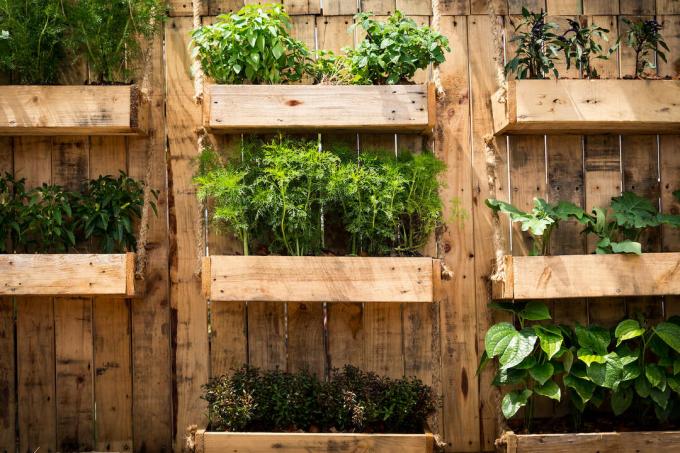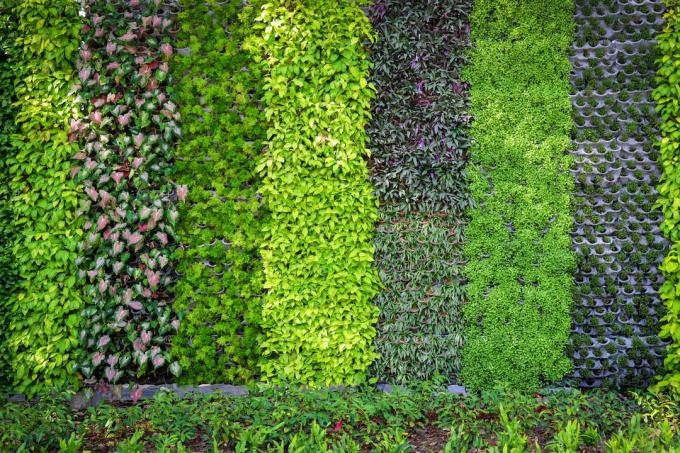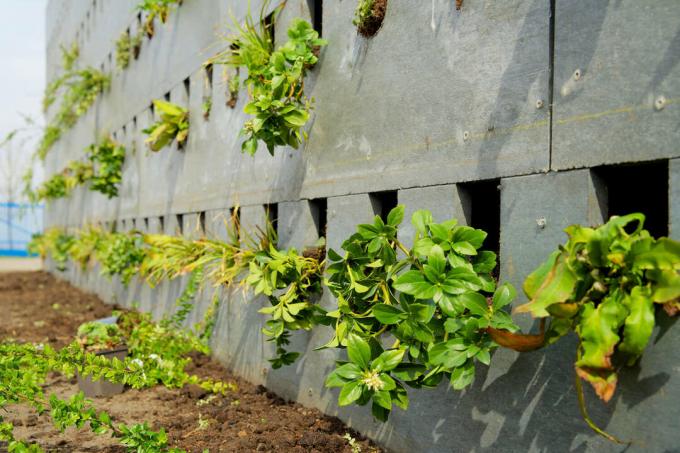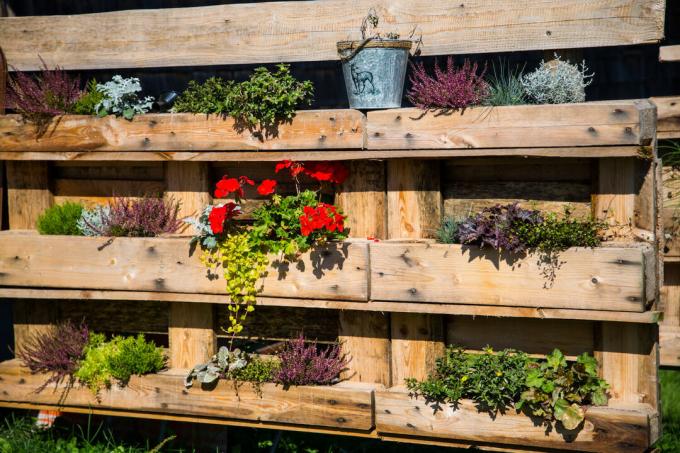Green facades are an integral part of the cities of the future. However, vertical gardening can also find its way into your own home.

Vertical gardening - or "vertical gardening" as it is often used in English - has received more and more attention in recent years. Instead of looking for the space needed for gardening on a flat surface, the cultivation of the plants is shifted upwards. Various constructions rise steeply and offer the possibility of growing plants on several floors. A distinction is made between two main forms of vertical gardening:
- Vertical gardening as facade greening or as a wall garden in the interior
- Vertical gardening for growing vegetables in a limited space, such as the balcony
contents
- Vertical garden - wall garden for more quality of life
- Vertical Garden - Build it yourself for the balcony
- Possible constructions for a DIY vertical garden
- Vertical garden made of pallet or tubes
Vertical garden - wall garden for more quality of life
It doesn't matter whether it's a modern skyscraper, the facade of an old building or the interior of an open-plan office - vertical gardens or facade greening are becoming more and more common in our living space. The vertical use of plants as a building element is the hobby horse of some future-oriented architects. In the models of modern future cities, green towers that stand out from the cityscape are an integral part. They are intended to improve the attitude towards life in the increasingly cramped urban space and also ensure that the polluted city air is cleaned.

Now you could simply let an ivy or vine climb up the wall and the facade greening would be complete. However, the innovation of vertical gardening on houses is that constructions are created by plants can live on their own roots in the air without having to climb up the wall from the very bottom have to. Devices that provide space for substrate for vertical garden plants to spread their roots are the foundation of this eye-popping cultivation style. The watering of the high-altitude plants can also be carried out using hydroponic systems. No organic substrates such as those based on peat are used, but the plants are only supplied with special nutrient solutions. No matter which substructure is selected for the vertical garden in the interior or on the outside facade - the wall garden is always expensive.
Vertical Garden - Build it yourself for the balcony
"DIY - Do it yourself" is just as trendy as vertical gardens, for example for your own balcony. And the towering constructions can also be easily built by yourself in order to grow ornamental flowers and crunchy, fresh vegetables in a small space. Having your own vertical garden has a number of advantages:
- Effective use of very limited acreage
- Cultivation (also of vegetables) possible in a very limited space
- Opportunity to green the urban space
- Decorative and relaxing eye-catcher

Of course, there are many different ways to design and build a vertical garden yourself. The integration of an irrigation system in the vertical garden should also be considered. Because depending on the system, it is difficult to give water to the plants in need.
Possible constructions for a DIY vertical garden
- Wall garden with substrate
- Wall garden with hydroponic system for supply
- Pallet vertical garden
- Column construction with pipes from the hardware store
If a large wall area is available for vertical gardening, it makes sense to create a wall garden. However, this means intensive care and a sophisticated irrigation system is required to optimally care for the plants. If less space is available, you can easily come back to constructions made of pallets or pipes. These are also easier to install.
Vertical garden made of pallet or tubes
The use of pallets as a living element is absolutely trendy. And this all-rounder piece of furniture can also be used perfectly as a vertical garden.

A pallet becomes a vertical garden
Here is a quick guide on how to turn a pallet into a vertical garden for the balcony or patio:
- Place the pallet upright so that the boards on the top are across.
- Staple burlap to the boards on the top from the inside.
- Staple the pond liner in place from behind, below and the two short sides. The top of the pallet is left open to fill in soil.
- Fill in a suitable substrate for the crops to be grown. Since the substrate should not be constantly exchanged, it is advisable to use a more nutrient-rich substrate like ours from the start Plantura organic tomato & vegetable soil to use.
- Cut small slits in the linen from the front of the pallet. These should be just big enough for the root ball of the plants to fit through and set into the substrate inside the pallet.
- The water supply can be made either via the upper open side of the pallet or directly at the root through the small slits in the linen.

Plantura organic tomato & vegetable soil
Organic, peat-free & climate-friendly:
For all types of vegetables and berries,
ensures a rich and aromatic harvest, harmless to humans and animals
More on growing herbs in one Herb wall made of palletsYou can find out how to build them yourself and plant them properly in our special article.
Pipes from the hardware store become a vertical garden
The garden from a palette shown above looks trendy and makes the most of the limited space available. The disadvantage, however, is that the wooden pallet is in direct contact with the permanently moist substrate - just like the linen, which holds the substrate in the body of the pallet. Thus, this construction is not for eternity and must be replaced as soon as the ravages of time have gnawed at it too much. Alternatively, you can also create a vertical garden for the balcony from weather and water-resistant pipes from the hardware store. These constructions are reminiscent of Mediterranean herb pots for balconies and terraces. You can find out how to do this here:
- Get plastic water/sewage pipes from a hardware store.
- Optimal diameter of 110 mm, lengths from 0.5 m to 2 m well suited for a vertical garden. However, the longer the vertical garden is built here, the more complicated it can become with watering.
- Drill holes with a diameter of 3 to 4 cm in the pipes with a saw drill. These will later represent the planting holes - so choose the distance accordingly. From an irrigation point of view, it is smart to put more holes in the top part of the pipe than in the bottom part.
- If the watering of the plants is skilfully dosed, an end cap can simply be placed on the lower end of the pipe. Otherwise a drainage can be installed.
- The substrate can be filled in and the plants used.
- The longer the vertical pipe garden, the easier it will tip over. Therefore, it should be fixed in a suitable place.
No matter which form of vertical garden you choose - in any case you have one Eye-catcher and more possibility created, even with limited space, not to do without plants have to.
For more vertical garden inspiration, visit our Pinterest page:
...and receive concentrated plant knowledge and inspiration directly in your e-mail inbox every Sunday!
